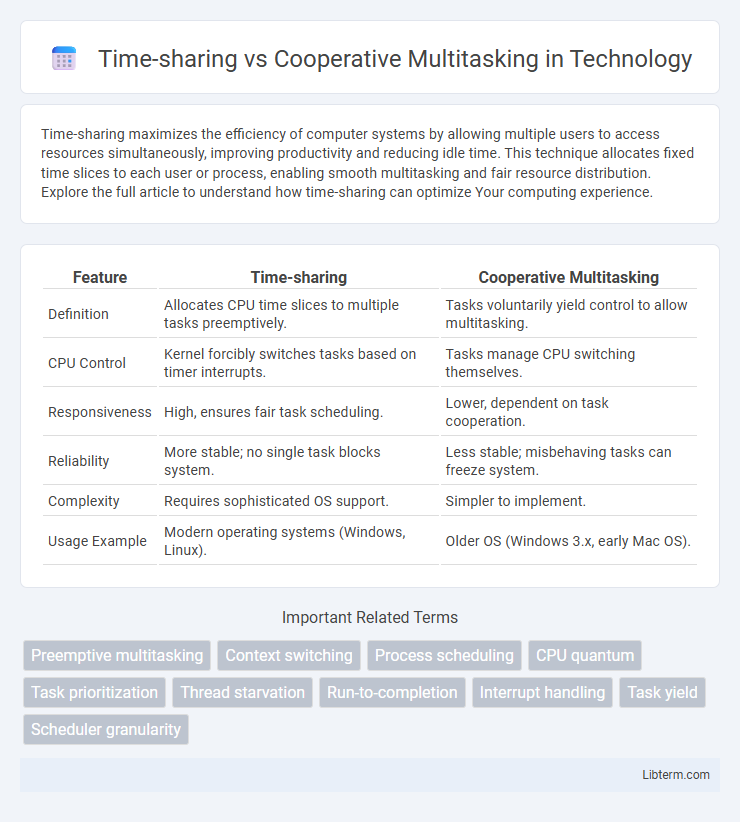Time-sharing maximizes the efficiency of computer systems by allowing multiple users to access resources simultaneously, improving productivity and reducing idle time. This technique allocates fixed time slices to each user or process, enabling smooth multitasking and fair resource distribution. Explore the full article to understand how time-sharing can optimize Your computing experience.
Table of Comparison
| Feature | Time-sharing | Cooperative Multitasking |
|---|---|---|
| Definition | Allocates CPU time slices to multiple tasks preemptively. | Tasks voluntarily yield control to allow multitasking. |
| CPU Control | Kernel forcibly switches tasks based on timer interrupts. | Tasks manage CPU switching themselves. |
| Responsiveness | High, ensures fair task scheduling. | Lower, dependent on task cooperation. |
| Reliability | More stable; no single task blocks system. | Less stable; misbehaving tasks can freeze system. |
| Complexity | Requires sophisticated OS support. | Simpler to implement. |
| Usage Example | Modern operating systems (Windows, Linux). | Older OS (Windows 3.x, early Mac OS). |
Introduction to Multitasking in Computing
Multitasking in computing enables multiple processes to share system resources efficiently, enhancing overall performance and user experience. Time-sharing allocates fixed CPU time slices to each process in a round-robin fashion, ensuring fair access and responsiveness. Cooperative multitasking relies on each process to yield control voluntarily, which can lead to resource contention and decreased system stability if a process fails to release the CPU.
What is Time-Sharing?
Time-sharing is a computing technique that allows multiple users or processes to access a central processor simultaneously by rapidly switching the CPU's time among them, enhancing system efficiency and responsiveness. It divides CPU time into small units called time slices or quanta, ensuring each process runs for a short period before the next one executes. This method contrasts with cooperative multitasking, where processes voluntarily yield control, as time-sharing enforces preemptive scheduling to avoid process monopolization of the CPU.
Understanding Cooperative Multitasking
Cooperative multitasking relies on each running process to voluntarily yield control of the CPU, which requires well-behaved applications to prevent system unresponsiveness. Unlike time-sharing systems that preemptively allocate CPU time slices to processes, cooperative multitasking depends on processes to manage CPU usage efficiently. This method simplifies system design but risks bottlenecks if any single task fails to release control, impacting overall system performance and responsiveness.
Core Differences Between Time-Sharing and Cooperative Multitasking
Time-sharing operates by allocating fixed time slices to each process, ensuring system resources are distributed evenly and preventing any single task from monopolizing the CPU. Cooperative multitasking relies on processes voluntarily yielding control to allow other tasks to execute, which can lead to system hangs if a process fails to release the CPU. The primary difference lies in the control mechanism: time-sharing enforces preemption through the operating system, while cooperative multitasking depends on the goodwill of each process to share CPU time.
System Resource Management Comparison
Time-sharing allocates CPU time slices to multiple processes, enabling fair and efficient usage of system resources by preempting tasks, thus preventing any single process from monopolizing the CPU. Cooperative multitasking relies on each process to voluntarily yield control, which can lead to inefficient resource utilization and potential system freezes if a process fails to release the CPU. Time-sharing systems improve system responsiveness and resource distribution through centralized scheduling, whereas cooperative multitasking's resource management depends heavily on the cooperation and design of individual processes.
Performance and Efficiency Analysis
Time-sharing systems allocate CPU time slices to multiple processes, enhancing overall system responsiveness and ensuring equitable resource distribution, which improves performance under heavy multitasking workloads. Cooperative multitasking relies on processes to yield control voluntarily, often resulting in inefficiencies and potential system unresponsiveness when a process fails to release the CPU, leading to degraded performance. Performance benchmarks reveal that time-sharing achieves higher throughput and better CPU utilization, while cooperative multitasking may suffer from bottlenecks due to lack of enforced context switching, impacting efficiency in multi-user environments.
User Experience: Responsiveness and Stability
Time-sharing systems enhance user experience by allocating CPU time slices to multiple processes, ensuring consistent responsiveness and preventing any single application from monopolizing resources. Cooperative multitasking relies on each process to yield control voluntarily, which can lead to unresponsiveness if a process fails to do so, impacting system stability and user interaction. Modern operating systems favor time-sharing to maintain a stable environment with predictable responsiveness, improving overall usability and minimizing system freezes.
Security and Process Isolation
Time-sharing systems provide enhanced process isolation by allocating fixed CPU time slices to each process, reducing the risk of one process interfering with another. Cooperative multitasking relies on processes to yield control voluntarily, which can lead to security vulnerabilities if a malfunctioning or malicious process refuses to release the CPU. Time-sharing's preemptive nature offers stronger security guarantees by preventing processes from monopolizing resources and isolating faults more effectively.
Real-World Applications and Use Cases
Time-sharing systems are widely used in modern operating systems like Linux and Windows to efficiently allocate CPU resources among multiple users and processes, enhancing responsiveness in environments such as web servers and cloud computing platforms. Cooperative multitasking, once common in early versions of Windows and Mac OS, relies on each process yielding control, making it suitable for simpler, less resource-intensive applications like embedded systems or legacy software where predictability outweighs concurrency needs. Real-world applications prefer time-sharing for scalability and fairness, while cooperative multitasking remains relevant in controlled, real-time scenarios requiring deterministic task management.
Future Trends in Multitasking Techniques
Future trends in multitasking techniques emphasize the evolution of time-sharing systems towards more dynamic resource allocation using AI-driven schedulers that optimize CPU utilization and responsiveness. Cooperative multitasking is expected to integrate safer, automated context-switching mechanisms to minimize application freezes and improve user experience. Emerging hybrid models will combine the real-time efficiency of time-sharing with the control precision of cooperative multitasking, leveraging advances in machine learning and hardware acceleration.
Time-sharing Infographic

 libterm.com
libterm.com